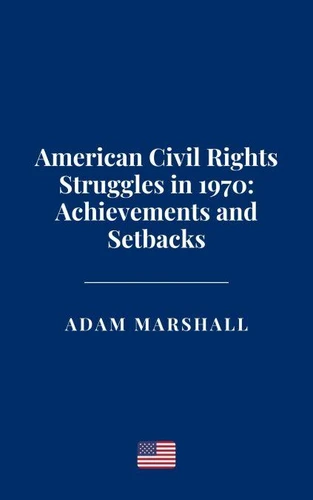American Civil Rights Struggles in 1970: Achievements and Setbacks
Par :Formats :
Disponible dans votre compte client Decitre ou Furet du Nord dès validation de votre commande. Le format ePub est :
- Compatible avec une lecture sur My Vivlio (smartphone, tablette, ordinateur)
- Compatible avec une lecture sur liseuses Vivlio
- Pour les liseuses autres que Vivlio, vous devez utiliser le logiciel Adobe Digital Edition. Non compatible avec la lecture sur les liseuses Kindle, Remarkable et Sony
 , qui est-ce ?
, qui est-ce ?Notre partenaire de plateforme de lecture numérique où vous retrouverez l'ensemble de vos ebooks gratuitement
Pour en savoir plus sur nos ebooks, consultez notre aide en ligne ici
- FormatePub
- ISBN8230172017
- EAN9798230172017
- Date de parution09/03/2025
- Protection num.pas de protection
- Infos supplémentairesepub
- ÉditeurIndependently Published
Résumé
The year 1970 marked a pivotal moment in the long and tumultuous history of the American Civil Rights Movement, a year that both reflected the triumphs of the past and set the stage for the struggles yet to come. By 1970, the achievements of the 1960s, including the landmark Civil Rights Act of 1964 and the Voting Rights Act of 1965, had undeniably reshaped the legal and social landscape of the United States.
However, as the nation entered the 1970s, it was increasingly clear that legal victories alone could not dismantle the deep structural inequalities that plagued American society. The Civil Rights Movement, which had been largely defined by the charismatic leadership of Martin Luther King Jr. and other nonviolent figures, was at a crossroads. The question of how to move forward, in light of both progress and persistent injustice, had grown more complicated.
However, as the nation entered the 1970s, it was increasingly clear that legal victories alone could not dismantle the deep structural inequalities that plagued American society. The Civil Rights Movement, which had been largely defined by the charismatic leadership of Martin Luther King Jr. and other nonviolent figures, was at a crossroads. The question of how to move forward, in light of both progress and persistent injustice, had grown more complicated.
The year 1970 marked a pivotal moment in the long and tumultuous history of the American Civil Rights Movement, a year that both reflected the triumphs of the past and set the stage for the struggles yet to come. By 1970, the achievements of the 1960s, including the landmark Civil Rights Act of 1964 and the Voting Rights Act of 1965, had undeniably reshaped the legal and social landscape of the United States.
However, as the nation entered the 1970s, it was increasingly clear that legal victories alone could not dismantle the deep structural inequalities that plagued American society. The Civil Rights Movement, which had been largely defined by the charismatic leadership of Martin Luther King Jr. and other nonviolent figures, was at a crossroads. The question of how to move forward, in light of both progress and persistent injustice, had grown more complicated.
However, as the nation entered the 1970s, it was increasingly clear that legal victories alone could not dismantle the deep structural inequalities that plagued American society. The Civil Rights Movement, which had been largely defined by the charismatic leadership of Martin Luther King Jr. and other nonviolent figures, was at a crossroads. The question of how to move forward, in light of both progress and persistent injustice, had grown more complicated.




















